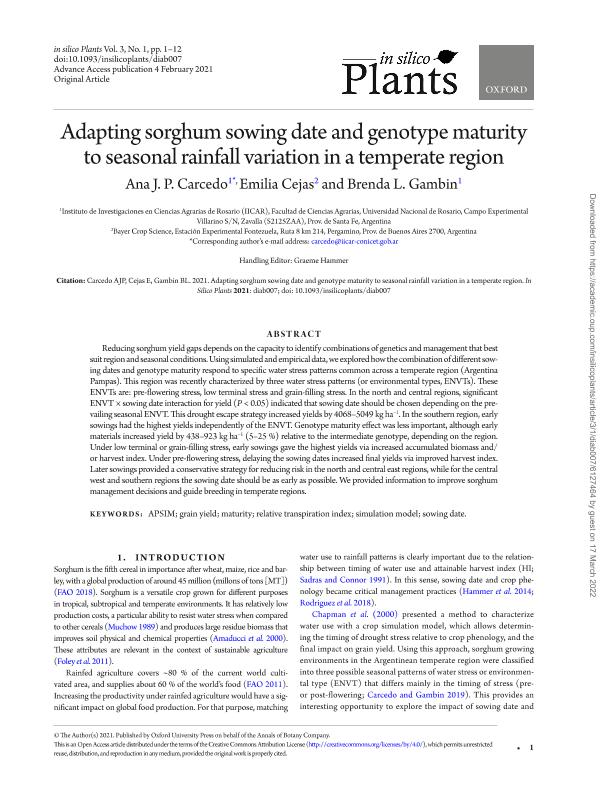Mostrar el registro sencillo del ítem
dc.contributor.author
Carcedo, Ana Julia Paula

dc.contributor.author
Cejas, Emilia
dc.contributor.author
Gambin, Brenda Laura

dc.date.available
2023-09-13T15:41:23Z
dc.date.issued
2021-02
dc.identifier.citation
Carcedo, Ana Julia Paula; Cejas, Emilia; Gambin, Brenda Laura; Adapting sorghum sowing date and genotype maturity to seasonal rainfall variation in a temperate region; Oxford University Press; In Silico Plants; 3; 1; 2-2021; 1-12
dc.identifier.issn
2517-5025
dc.identifier.uri
http://hdl.handle.net/11336/211400
dc.description.abstract
Reducing sorghum yield gaps depends on the capacity to identify combinations of genetics and management that best suit region and seasonal conditions. Using simulated and empirical data, we explored how the combination of different sowing dates and genotype maturity respond to specific water stress patterns common across a temperate region (Argentina Pampas). This region was recently characterized by three water stress patterns (or environmental types, ENVTs). These ENVTs are: pre-flowering stress, low terminal stress and grain-filling stress. In the north and central regions, significant ENVT × sowing date interaction for yield (P < 0.05) indicated that sowing date should be chosen depending on the prevailing seasonal ENVT. This drought escape strategy increased yields by 4068-5049 kg ha-1. In the southern region, early sowings had the highest yields independently of the ENVT. Genotype maturity effect was less important, although early materials increased yield by 438-923 kg ha-1 (5-25 %) relative to the intermediate genotype, depending on the region. Under low terminal or grain-filling stress, early sowings gave the highest yields via increased accumulated biomass and/or harvest index. Under pre-flowering stress, delaying the sowing dates increased final yields via improved harvest index. Later sowings provided a conservative strategy for reducing risk in the north and central east regions, while for the central west and southern regions the sowing date should be as early as possible. We provided information to improve sorghum management decisions and guide breeding in temperate regions.
dc.format
application/pdf
dc.language.iso
eng
dc.publisher
Oxford University Press

dc.rights
info:eu-repo/semantics/openAccess
dc.rights.uri
https://creativecommons.org/licenses/by-nc-sa/2.5/ar/
dc.subject
APSIM
dc.subject
GRAIN YIELD
dc.subject
MATURITY
dc.subject
RELATIVE TRANSPIRATION INDEX
dc.subject
SIMULATION MODEL
dc.subject
SOWING DATE
dc.subject.classification
Agricultura

dc.subject.classification
Agricultura, Silvicultura y Pesca

dc.subject.classification
CIENCIAS AGRÍCOLAS

dc.title
Adapting sorghum sowing date and genotype maturity to seasonal rainfall variation in a temperate region
dc.type
info:eu-repo/semantics/article
dc.type
info:ar-repo/semantics/artículo
dc.type
info:eu-repo/semantics/publishedVersion
dc.date.updated
2023-09-13T11:52:06Z
dc.journal.volume
3
dc.journal.number
1
dc.journal.pagination
1-12
dc.journal.pais
Reino Unido

dc.description.fil
Fil: Carcedo, Ana Julia Paula. Consejo Nacional de Investigaciones Científicas y Técnicas. Centro Científico Tecnológico Conicet - Rosario. Instituto de Investigaciones en Ciencias Agrarias de Rosario. Universidad Nacional de Rosario. Facultad de Ciencias Agrarias. Instituto de Investigaciones en Ciencias Agrarias de Rosario; Argentina
dc.description.fil
Fil: Cejas, Emilia. Estación Experimental Fontezuela; Argentina
dc.description.fil
Fil: Gambin, Brenda Laura. Consejo Nacional de Investigaciones Científicas y Técnicas. Centro Científico Tecnológico Conicet - Rosario. Instituto de Investigaciones en Ciencias Agrarias de Rosario. Universidad Nacional de Rosario. Facultad de Ciencias Agrarias. Instituto de Investigaciones en Ciencias Agrarias de Rosario; Argentina
dc.journal.title
In Silico Plants
dc.relation.alternativeid
info:eu-repo/semantics/altIdentifier/doi/http://dx.doi.org/10.1093/insilicoplants/diab007
Archivos asociados
